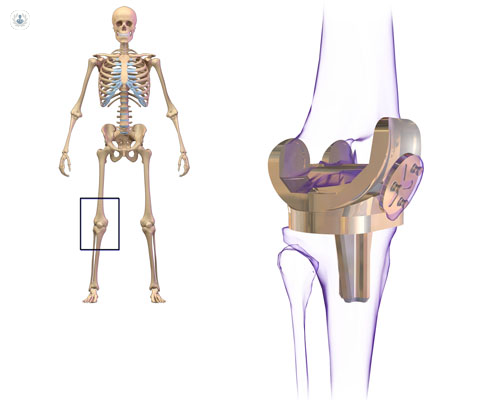How is robotic knee replacement performed?
Written in association with:In this article below, distinguished consultant orthopaedic surgeon, Mr Giles Heilpern, discusses the process involved in a robotic knee replacement, whilst also outlining the associated benefits and risks.

What is meant by robotic knee replacement?
Robotic knee replacement is a cutting-edge surgical procedure that offers enhanced precision and improved outcomes for patients suffering from severe knee arthritis or other debilitating knee conditions. This advanced technique leverages robotic technology to assist surgeons in performing knee replacement surgeries with remarkable accuracy, ultimately leading to better patient experiences and quicker recoveries.
What does a robotic knee replacement process entail?
The robotic knee replacement process begins with a comprehensive preoperative plan. Advanced imaging, such as a CT scans or MRI, is used to create a detailed 3D model of the patient’s knee.
This model allows the surgeon to thoroughly analyse the knee’s anatomy, identify any abnormalities, and plan the surgery with a high degree of precision. The preoperative plan includes determining the optimal size and placement of the knee implant, ensuring a tailored fit for each patient.
How is it performed?
During the surgery, the robotic system provides real-time feedback and guidance to the surgeon. This system typically consists of a robotic arm controlled by the surgeon, which assists in making precise bone cuts and placing the implant with exceptional accuracy.
The robotic technology ensures that even the smallest adjustments can be made during the procedure, enhancing the alignment and stability of the implant. This level of precision is difficult to achieve with traditional surgical methods.
What are the main associated benefits of robotic knee replacement?
One of the primary benefits of robotic knee replacement is the improved alignment and positioning of the implant. Proper alignment is crucial for the longevity and function of the knee replacement.
Misalignment can lead to uneven wear, instability, and increased risk of complications. With robotic assistance, the chances of achieving perfect alignment are significantly higher, resulting in better long-term outcomes for patients.
Patients who undergo robotic knee replacement often experience several benefits compared to traditional knee replacement surgery. These include reduced postoperative pain, shorter hospital stays, faster recovery times, and improved knee function. The minimally invasive nature of the procedure, combined with the precise placement of the implant, contributes to these positive outcomes.
Are there any risks?
As with any surgical procedure, there are risks associated with robotic knee replacement, including infection, blood clots, and complications related to anaesthesia. However, the advanced planning and precision of robotic-assisted surgery can help minimize these risks.
To consult with Mr Giles Heilpern today, simply visit his Top Doctors profile.


